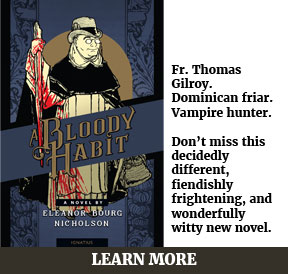When we encounter the works of Dickens, Waugh, Eliot, and O’Connor; Beethoven, Mozart, and Tchaikovsky; Da Vinci, Rembrandt, and Picasso, we are amazed at the abundance of creativity, far surpassing that of “mere mortals”, art so sublime, so beautiful, so moving, that we can only marvel at it.
So why do misery, lost-ness, and even depravity, so often accompany this creative gift? We have all read about immensely talented artists—in the broad sense of the word—who have committed suicide, or destroyed themselves with alcohol, drugs, vendettas, sexual misadventures, and perversions. When we examine their work in relation to these behaviors, we cannot help but be perplexed by the juxtaposition of beauty and ugliness.
One might say that with abundant gifts come abundant perils. Looking into individual hearts isn’t possible, but the phenomenon is so common that it begs examination. One interpretation is that human gifts—“consolations”, have corresponding burdens—“desolations”, just as rain that produces lovely flowers also produces weeds. Artists have vivid imaginations, vivid memories, and vivid intuitions, but along with these gifts come looking glasses and rabbit holes, into which they often fall and lose their way.
Interior and exterior trials plague these abundantly talented artists. We might liken the interior trial to pouring a rich fermenting wine into a wineskin. What comes out may be a delicious wine, but the fermentation process can also produce eruptions and leaks, and may even cause the wineskin to burst apart. As to the exterior trial, the fame, notoriety, and demands that come from producing publicly lauded art may be more than the artist has bargained for, or is capable of experiencing without losing his bearings. Like Eliza Doolittle, many are uncomfortable in this new public world, but they are averse to going back to selling flowers, to a life of anonymity, just writing or drawing or composing for themselves and a few others. The combination of these interior and exterior trials may produce a life that spins out of its proper orbit and goes careening through space until it is lost, or smashes into another out-of-control life.
So how are some of these abundantly creative people able to avoid being consumed or annihilated by this creative fission?
As related in a recent Washington Post review of The Mockingbird Next Door, a book about Harper Lee and her sister, the author, Marja Mills, asks both sisters and their friend (and pastor) why Harper Lee never wrote another novel. Because, Mills was told, it was hard to live up to the “impossible expectations” engendered by To Kill A Mockingbird. Furthermore, Harper Lee hated the publicity and public attention—the exterior trial that brings so many to their knees. Lee’s childhood friend, Truman Capote—her character, Dill, was based on Capote—didn’t possess such self-knowledge and wisdom, with Lee stating, “He thought the rules that apply to everyone else didn’t apply to him.” Doesn’t this sum up why so many, including those with an abundance of creativity, crash and burn?
“But we hold this treasure in earthen vessels that the surpassing power may be of God and not of us.” When we—earthen vessels—try to appropriate this treasure, this surpassing power, to ourselves, bad things happen. Tolkien depicted this in the contrast between Gandalf and Saruman; the one using his wizardly power—in trust, as it were—to benefit others, while Saruman uses his power for self-aggrandizing and, ultimately, destructive ends.
Haven’t we witnessed the regulating power of this truth in the lives of many artists of faith? Not to say that these are spared the trials that accompany the creative gift, but they have a point of reference—a reality, a truth—that artists lacking a transcendent perspective do not possess and cannot comprehend. They know that the wineskin of their human nature cannot accept an overabundance of fermenting wine, and they know that their ultimate destination is neither the Ascot Racecourse nor Covent Garden.
The creative seed can fall on the path, on rocky ground, among thorns, even within the same person, but with virtue, and the cooperation of the human artist with the sower—even when this cooperation occurs sporadically or later in the artist’s life—the seed may bear abundant fruit.






Leave a Reply